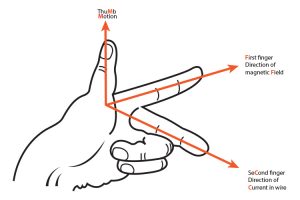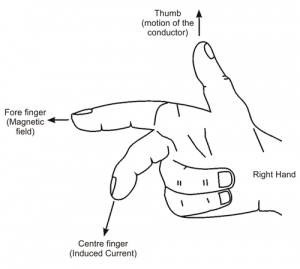Fleming’s Left-Hand Rule and Fleming’s Right-Hand Rule Guide
If you want to calculate the effect of a magnetic field on a current-carrying conductor, then it is only possible with the help of the Flemings Left-Hand and Right-Hand rule. Moreover, these principles play a vital role in solving various types of problems and understanding major topics and chapters in Physics. However, for people who are learning these principles for the first time, they will be a bit confusing and hard to understand. Thus, to help you out, we will provide a brief description of Fleming’s Left Hand and Right-Hand Rule in much more detail.
Fleming’s Left-Hand Rule

Fleming’s Left-Hand Rule or the rule of motors is necessary to calculate the direction of force when a current-carrying conductor is placed in a magnetic field. For this rule, the individual must stretch the thumb, index finger, and middle finger in a way that they all stay perpendicular to each other. And at the same time, the conductor placed inside the magnetic field will experience a magnetic force.

Each Finger direction represents an individual quantity as shown on the Fleming Left Hand Rule Diagram.
- Thumb: It usually points towards the direction of Force(F).
- Index Finger: It represents the Direction of the Magnetic Field(B).
- Middle Finger: It states the direction of the Current(I).
Fleming’s Right-Hand Rule

As you can guess from the above section, this law is useful to find out the direction of induced current when a conductor that has current passing through it is kept inside a magnetic field, where it will experience the magnetic force. Similar to the Fleming left-hand rule, the three fingers in the Fleming right hand represent different quantities such as Induced Current, Magnetic Field, and the Direction of Induced Current.
- Thumb: It states the direction of Motion of the Conductor.
- Index Finger: It represents the Direction of Magnetic Field(B)
- Middle Finger: It points in the direction of the Induced Current(I).
Difference Between Fleming’s Left-Hand Rule and Fleming’s Right-Hand Rule
Now that you have understood the basics of the Fleming Left-Hand rule and Right-Hand Rule. Let us now talk about the differences between these two rules in more detail below.
| Fleming’s Left-Hand Rule | Fleming’s Right-Hand Rule |
| Only applicable for Electric Motors | Only applicable for Electric Generators |
| The middle finger on the left hand represents the direction of current | The middle finger on the right hand represents the direction of induced current(I) |
| This rule helps the students to find the direction of the magnetic force acting on the current carrying conductor | This rule helps students to find the direction of induced current in an electrical generator.
|
Conclusion
In the above article, we have talked about Fleming’s Left-Hand and Right-Hand Rule, and the various applications, etc. However, if you are finding it hard to study on your own, especially the concepts in the Physics subject. Then it is better for you to join the online interactive classes offered by Tutoroot, where you can get expert guidance, and access to the best study materials, as well as various other features at cost-effective prices.
Frequently Asked Questions
In Fleming’s Left-Hand Rule Thumb Indicates What?
From the above article, as you can guess, Fleming’s left-hand rule states that the thumb indicates the direction of force when a current carrying conductor is placed in a magnetic field.
How is the right-hand thumb rule different from Fleming’s left-hand rule?
There are multiple differences between the Flemings Left-Hand Rule and the Right-Hand Rule, such as
- The Left-Hand rule is applicable only for electric motors, while the right-hand rule is generally used for electric conductors.
- The Left-hand rule helps students to calculate or find the direction of magnetic force, and the right one helps them to find the direction of induced current.
- Third, the middle finger in the left-hand rule states, the direction of the current, and the right one state, the direction of the induced current.
State Fleming’s Left Hand Rule.
Fleming’s Left-Hand Rule or the rule of motors is necessary to calculate the direction of force when a current-carrying conductor is placed in a magnetic field.
State Fleming’s Right-Hand Rule.
Fleming’s Right Hand Rule is useful to find out the direction of induced current when a conductor that has current passing through it, is kept inside a magnetic field.

2 thoughts on “Fleming’s Left-Hand Rule and Fleming’s Right-Hand Rule Guide”